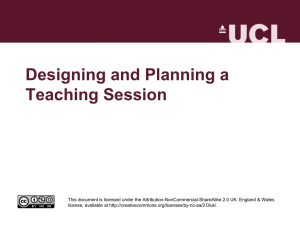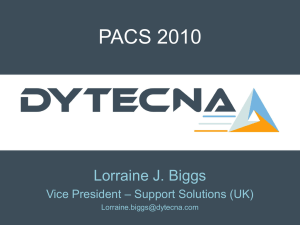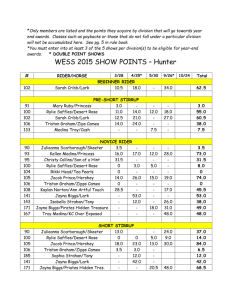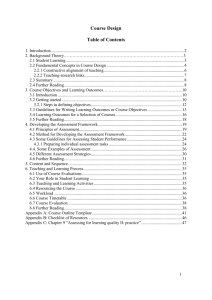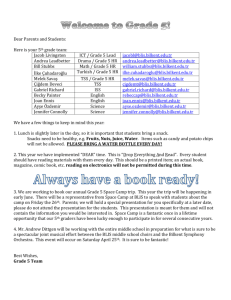Effective Teaching at Bilkent University
advertisement
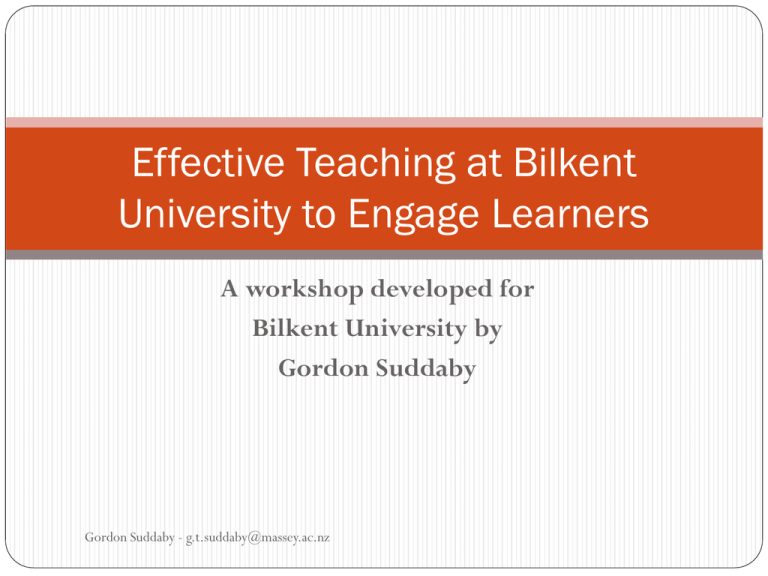
Effective Teaching at Bilkent University to Engage Learners A workshop developed for Bilkent University by Gordon Suddaby Gordon Suddaby - g.t.suddaby@massey.ac.nz Rationale If students are to learn desired outcomes in a reasonably effective manner, then the teacher’s fundamental task is to get students to engage in learning activities that are likely to result in their achieving those outcomes...It is helpful to remember that what the student does is actually more important in determining what is learned than what the teacher does. Thomas J. Shuell (1986) cited in Biggs and Tang (2007) Overview This workshop will focus on developing and enhancing approaches which engage students in the Teaching – Learning relationship that you, as Bilkent teachers are responsible for. The workshop will draw from research-based theory, including John Bigg’s notion of constructive alignment, to explore how the elements that go to create effective university learning i.e. curriculum design, assessment, teaching approaches, learning resources, motivation, relevance, and relationship development may be brought together to achieve successful outcomes to provide a range of strategies able to be used in your teaching. Programme for the workshop 9.00 9.20 10.30 10.40 11.40 11.50 13.00 13.30 14.00 14.30 Setting the Scene Evaluating and improving Teaching Break Assessing Student Learning Break Active Learning Lunch (provided) Motivating Students Academic Integrity Close Your Expectations On the paper provided, please indicate your reason for attending this workshop. Also list up to 5 expectations that you have arising from your attendance; NB this will be collected in at the end of the workshop, but will be anonymous and will be used for my purposes of evaluation and improvement. Intended learning outcomes Participants will be able to: articulate an understanding of student learning and how this relates to effective teaching practice; identify and implement effective teaching and learning strategies; identify and apply key assessment concepts; establish and maintain productive student-teacher learning relationships Identify and implement a range of strategies that will enhance student engagement, motivation and success identify and use a variety of strategies for gaining feedback on teaching Setting the Scene Introducing the assumptions, theory, research evidence and principles that underpin effective university teaching and learning Is this how we feel after a semester of teaching? Activity 1: What are the teaching and learning issues that are foremost in your minds? In Departmental/Faculty pairs identify as many teaching and learning issues as you can which affect your Department/Faculty Combine with another pair, compare your list and identify the top four issues Be prepared to discuss these with the whole group Think about how these impact on the quality of teaching!!! What are Bilkent’s view’s of teaching... The Bilkent website states that; “Good teaching is essential for all”. The website goes on to define quality teaching when it states: “Quality means making the students learn by stimulating their interest in the topic, by challenging their capabilities, and by encouraging active participation and ‘doing’” The website also stresses that; “Learning means more than rote memorization of facts; hence teachers are expected to enhance students analytical, critical, and independent thinking abilities”. What are the implications of this ‘policy’? What does the literature say about good teachers? Good teachers are; Knowledgeable about their subject Adopt an organised and systematic approach to their teaching Are enthusiastic and interesting Respect their students Have high expectations of their students performance From: Prebble, Hargraves, Leach, Naidoo, Suddaby and Zepke (2005) Activity 2: What is teaching all about? “All teachers have some theory of what teaching is when they are doing it, even if they are not explicitly aware of that theory...” Gow and Kember, 1993 cited in Biggs and Tang, 2007, p.15. Task (from Biggs and Tang, 2007, p.16) What are your theories of teaching and learning? Learning is........ Teaching is....... Activity 2: What is teaching all about? “All teachers have some theory of what teaching is when they are doing it, even if they are not explicitly aware of that theory...” Gow and Kember, 1993 cited in Biggs and Tang, 2007, p.15. Task (from Biggs and Tang, 2007, p.16 What are your theories of teaching and learning? Learning is........ Teaching is....... Share your ideas with the person next to you and identify common points Some assumptions about teaching Teaching is a process not an event There is no one right way to teach, but there are many ways to teach better Both teachers AND students are responsible for learning Learning is more likely to occur if the process has been planned Assessment drives learning Learning occurs best in a relevant context And most importantly... Teachers want to teach better Some assumptions about learners? Learners are individuals needing to be engaged through approaches that support interactivity, collaboration, reflection, critique, and personalisation and; normally start with high motivation to succeed learn quickly when new learning is linked to prior knowledge may have to unlearn some things like to see the relevance of what they are learning learn best when they are physically and mentally comfortable like to be actively involved and engaged like to contribute to the learning journey need to experience success Are usually good judges of their own competence and performance Thinking about teaching Biggs has suggested that there are three levels of thinking about teaching Level 1 focus: What the student is Level 2 focus: What the teacher does Level 3 focus: What the student does Biggs and Tang, (2007) chap. 2 Activity 3: Models of Teaching (Biggs and Tang) Form groups of 3 Members of each group will be given an extract from Biggs and Tang (Chap 2) to read and discuss (either the extract on Level 1, Level 2, or Level 3) Task: Your task is to become an ‘expert’ on the material in your extract so that you are able to explain it to others. Models of teaching Reform in groups of 3 with a level 1, 2, and 3, reader in each group. In turn each group member will explain their extract to the other two group members. Then the whole group will discuss the 3 models. Write down and be prepared to report on: Comments the group has about the three models? How valid are these as representations? Where the groups theories of teaching and learning (noted earlier) agree/disagree with those of Biggs and Tang? What further questions are raised Model 1: Focus on what the student is Teachers tend to look at the student differences, i.e. the ‘good’ students and the ‘bad’ students The teacher is responsible for the content so in order to learn the students must; Attend lectures/classes Listen carefully Take full notes Do the reading Regurgitate the information in exams and assessments It is a ‘blame the student’ approach based on student deficits including; motivation, intelligence, attitude, study skills and aptitude etc Biggs and Tang, 2007 Model 2: Focus on what the student does Teachers try to ‘manage’ learning by using a battery of strategies (a ‘how to’ approach) by; Establishing procedural rules Ensuring clarity – voice, visuals, board work, ... Establishing eye-contact Using a wide variety of strategies It’s a ‘blame the teacher’ approach as it assumes that teaching involves the application of a range of strategies and competencies which are easy to quantify. Model 3: Focus on what the student does This is a ‘student-centred’ approach. The focus is on approaches that cause and support student learning and it will include a range of strategies which are integral to the approach by; Assisting students to understand facts, concepts and principles Using appropriate teaching/learning activities Engaging students on tasks focused on the learning outcomes Some thoughts on teaching and learning... Clearly, not all learning is dependent on teaching...However, all teaching regardless of quality is predicated on learning. (Brown, p.223 in Ellis, 1993) Teaching makes learning possible. Ramsden, p.114, 1992) Instructional difficulties do not occur because faculty are inept, or students capricious, they occur because components of the activities don’t fit the instructional circumstances in which they are used. Menges andWeimer, p.151, 1996. What is learning? Criteria that indicates learning has occurred involves; A change in a person’s behaviour or ability to do something A stipulation that this change must result from some sort of practice or experience A stipulation that the change is an enduring one Approaches to Learning Learning as a Process which involves; Constructivism Deep and surface learning These in turn involve; Authenticity Activity Engagement The constructivist approach Learning is an active process New knowledge is linked to existing knowledge Knowledge is developed in an organised manner There are multiple forms of knowledge Learning is a social act Learning is context dependent Learning focuses on cognitive processes and strategies Intrinsic motivation is critical Surface Learning Motivation is extrinsic (either +ve or –ve Involves rote learning and memorisation Only what is necessary is done Focuses on material delivered in lectures May not see connections or transferability Shortcuts are used Little engagement with the content Surface learning-type courses involve; heavy workload Long class hours Excessive course materials Lack of opportunity to pursue subjects in depth Lack of choice over topics Lack of choice over study methods A ‘threatening’ testing system A Deep Learning Intrinsic motivation Learners seek meaning and to satisfy curiosity Learners develop much content knowledge Learners operate at a high level of conceptualisation Learning is enjoyable Time and effort is put into learning (sometimes too much) Learner reflects on learning and thinks about how to learn Encouraging deep learning Emphasis on the knowledge base Learner is interested in the field – high motivation Interaction between learner, learners and teacher, and learner and content Learner actively participates (The learner is more than a ‘spectator’) Effective learning occurs when; What is already known is accessed New learning builds on what is already known The lecturer engages the learner (minds on) Learning occurs not by recording information, but by interpreting it and making it ours. Resnick The Bottom Line: The six characteristics of teaching and learning 1. Entails encounters with challenging ideas and people 2. Requires active engagement with those challenges 3. Occurs best in a supportive environment 4. Involves real-world activities 5. Is a relational, social activity 6. Is unbounded by time or place P. T. Terenzini and E. T. Pascarella (2004) The Challenges Ahead Align what we do with what we know. In looking to improve forget about Silver Bullets. Think systemically. Think collaboratively. Use the 6 characteristics of learning and development as touchstones in program planning, development, and evaluation Focus on first-year students. 2004 P. T. Terenzini and E. T. Pascarella Some questions for you as a teacher to consider What is your teaching philosophy? What are your teaching goals ? What do you know about your students ? How does your course fit with previous courses? How does your course link with subsequent courses? How does your course fit into the overall programme being offered? What do you want your students to learn? How can you give them the best chance of learning this? How can you find out if they have learned it? How can you judge the effectiveness of your teaching? What do you know about yourself as a teacher? Activity 4: Reflections Take any three of the questions listed on the previous slide and; 1. Provide brief responses that answer each question 2. Show how the answers link together 3. Identify where there are gaps or disjunctions 4. Write down what you might do about these 5. Write down a question that remains in your mind. Activity 4: Reflections Take any three of the questions listed on the previous slide and; 1. Provide brief responses that answer each question 2. Show how the answers link together 3. Identify where there are gaps or disjunctions 4. Write down what you might do about these 5. Write down a question that remains in your mind. 6. Share your responses in a small group and identify any points of interest/concern that you are happy to share with the whole group So It would seem that one of the big questions might be; How do I know how well I am teaching? How can I ensure my students learn what they should learn? AND How can I continue to improve?

